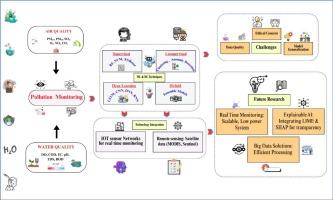Intelligence frameworks for environmental pollution assessment: a review on air and water quality monitoring systems
IF 5.6
2区 工程技术
Q1 ENGINEERING, MULTIDISCIPLINARY
引用次数: 0
Abstract
Environmental pollution monitoring is essential to human health protection, biodiversity preservation, and ecological degradation minimization. Traditional methods of establishing air and water quality are scientifically valid but normally suffer from flaws such as excessive operational cost, low spatial-temporal resolution, slow processing, and low scalability. Advances in machine learning have introduced superior alternatives to escape these flaws. Particularly noteworthy are supervised learning paradigms such as random forests, support vector machines, and deep neural networks, which have demonstrated immense success in pollutant forecasting, anomaly detection, and low-cost sensor array calibration. Deep learning architectures, e.g., convolutional neural networks (CNNs) and recurrent neural networks (RNNs), have also enabled high-accuracy spatiotemporal estimation, with the capability to capture nuanced environmental dynamics at increased spatial and temporal resolutions. The integration of machine learning with IoT sensors and satellite remote sensing platforms has further facilitated the development of scalable, autonomous environmental intelligence systems for real-time, continuous monitoring across diverse landscapes. This study contributes by addressing critical gaps in current ML-based environmental monitoring systems, particularly sensor drift, data sparsity, and model generalizability. It proposes strategic directions such as explainable AI (XAI), multimodal data fusion, and domain adaptation to enhance system performance and applicability. The innovative potential of this study lies in not only advancing environmental monitoring capabilities but also in laying a roadmap for future intelligent stewardship systems that will be scalable, transparent, and effective post-2025. This article aims to create a general synthesis of current breakthroughs, highlight key limitations, and propose future research directions for the evolution of intelligent environmental monitoring systems.

环境污染评估的情报框架:空气和水质监测系统综述
环境污染监测对保护人类健康、保护生物多样性和减少生态退化至关重要。传统的空气和水质测定方法具有科学有效性,但通常存在运行成本高、时空分辨率低、处理速度慢、可扩展性低等缺陷。机器学习的进步已经引入了更好的替代方案来避免这些缺陷。特别值得注意的是监督学习范式,如随机森林、支持向量机和深度神经网络,它们在污染物预测、异常检测和低成本传感器阵列校准方面取得了巨大成功。深度学习架构,例如卷积神经网络(cnn)和循环神经网络(rnn),也实现了高精度的时空估计,能够在增加的空间和时间分辨率下捕获细微的环境动态。机器学习与物联网传感器和卫星遥感平台的集成进一步促进了可扩展、自主的环境智能系统的发展,以便在不同的景观中进行实时、连续的监测。本研究通过解决当前基于ml的环境监测系统的关键缺陷,特别是传感器漂移、数据稀疏性和模型泛化性。提出了可解释人工智能(XAI)、多模态数据融合和领域自适应等战略方向,以提高系统性能和适用性。本研究的创新潜力不仅在于提高环境监测能力,还在于为2025年后可扩展、透明和有效的未来智能管理系统制定路线图。本文旨在对当前的突破进行综合,突出关键限制,并提出智能环境监测系统发展的未来研究方向。
本文章由计算机程序翻译,如有差异,请以英文原文为准。
求助全文
约1分钟内获得全文
求助全文
来源期刊

Measurement
工程技术-工程:综合
CiteScore
10.20
自引率
12.50%
发文量
1589
审稿时长
12.1 months
期刊介绍:
Contributions are invited on novel achievements in all fields of measurement and instrumentation science and technology. Authors are encouraged to submit novel material, whose ultimate goal is an advancement in the state of the art of: measurement and metrology fundamentals, sensors, measurement instruments, measurement and estimation techniques, measurement data processing and fusion algorithms, evaluation procedures and methodologies for plants and industrial processes, performance analysis of systems, processes and algorithms, mathematical models for measurement-oriented purposes, distributed measurement systems in a connected world.
 求助内容:
求助内容: 应助结果提醒方式:
应助结果提醒方式:


